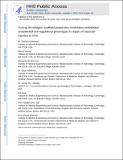| dc.contributor.author | Stanley, James R. L. | |
| dc.contributor.author | Unterman, Shimon A. | |
| dc.contributor.author | Freiman, Alina | |
| dc.contributor.author | Beckerman, Margarita | |
| dc.contributor.author | Abraham, Eytan | |
| dc.contributor.author | Levy, Ela | |
| dc.contributor.author | Edelman, Elazer R | |
| dc.contributor.author | Artzi, Natalie | |
| dc.date.accessioned | 2017-12-18T15:06:59Z | |
| dc.date.available | 2017-12-18T15:06:59Z | |
| dc.date.issued | 2015-10 | |
| dc.date.submitted | 2015-07 | |
| dc.identifier.issn | 2192-2640 | |
| dc.identifier.uri | http://hdl.handle.net/1721.1/112779 | |
| dc.description.abstract | Perivascularly implanted matrix embedded endothelial cells (MEECs) are potent regulators of inflammation and intimal hyperplasia following vascular injuries. Endothelial cells (ECs) in collagen scaffolds adopt a reparative phenotype with significant therapeutic potential. Although the biology of MEECs is increasingly understood, tuning of scaffold properties to control cell-substrate interactions is less well-studied. It is hypothesized that modulating scaffold degradation would change EC phenotype. Scaffolds with differential degradation are prepared by cross-linking and predegradation. Vascular injury increases degradation and the presence of MEECs retards injury-mediated degradation. MEECs respond to differential scaffold properties with altered viability in vivo, suppressed smooth muscle cell (SMC) proliferation in vitro, and altered interleukin-6 and matrix metalloproteinase-9 expression. When implanted perivascularly to a murine carotid wire injury, tuned scaffolds change MEEC effects on vascular repair and inflammation. Live animal imaging enables real-time tracking of cell viability, inflammation, and scaffold degradation, affording an unprecedented understanding of interactions between cells, substrate, and tissue. MEEC-treated injuries improve endothelialization and reduce SMC hyperplasia over 14 d. These data demonstrate the potent role material design plays in tuning MEEC efficacy in vivo, with implications for the design of clinical therapies. | en_US |
| dc.description.sponsorship | National Institutes of Health (U.S.) (Grant R01 GM 49039) | en_US |
| dc.publisher | Wiley Blackwell | en_US |
| dc.relation.isversionof | http://dx.doi.org/10.1002/ADHM.201500457 | en_US |
| dc.rights | Creative Commons Attribution-Noncommercial-Share Alike | en_US |
| dc.rights.uri | http://creativecommons.org/licenses/by-nc-sa/4.0/ | en_US |
| dc.source | PMC | en_US |
| dc.title | Tuning of Collagen Scaffold Properties Modulates Embedded Endothelial Cell Regulatory Phenotype in Repair of Vascular Injuries In Vivo | en_US |
| dc.type | Article | en_US |
| dc.identifier.citation | Unterman, Shimon et al. “Tuning of Collagen Scaffold Properties Modulates Embedded Endothelial Cell Regulatory Phenotype in Repair of Vascular Injuries In Vivo.” Advanced Healthcare Materials 4, 15 (September 2015): 2220–2228 © 2015 WILEY-VCH | en_US |
| dc.contributor.department | Institute for Medical Engineering and Science | en_US |
| dc.contributor.mitauthor | Unterman, Shimon A. | |
| dc.contributor.mitauthor | Freiman, Alina | |
| dc.contributor.mitauthor | Beckerman, Margarita | |
| dc.contributor.mitauthor | Abraham, Eytan | |
| dc.contributor.mitauthor | Levy, Ela | |
| dc.contributor.mitauthor | Edelman, Elazer R | |
| dc.contributor.mitauthor | Artzi, Natalie | |
| dc.relation.journal | Advanced Healthcare Materials | en_US |
| dc.eprint.version | Author's final manuscript | en_US |
| dc.type.uri | http://purl.org/eprint/type/JournalArticle | en_US |
| eprint.status | http://purl.org/eprint/status/PeerReviewed | en_US |
| dc.date.updated | 2017-12-15T13:58:07Z | |
| dspace.orderedauthors | Unterman, Shimon; Freiman, Alina; Beckerman, Margarita; Abraham, Eytan; Stanley, James R. L.; Levy, Ela; Artzi, Natalie; Edelman, Elazer | en_US |
| dspace.embargo.terms | N | en_US |
| dc.identifier.orcid | https://orcid.org/0000-0003-0838-3635 | |
| dc.identifier.orcid | https://orcid.org/0000-0002-7832-7156 | |
| mit.license | OPEN_ACCESS_POLICY | en_US |
